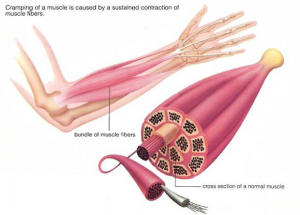 A muscle spasm is an involuntary contraction of a muscle, and is frequently painful. There are many different types of muscle spasms. Spasms can often be addressed through chiropractic care, improvement of diet or physical therapy.
A muscle spasm is an involuntary contraction of a muscle, and is frequently painful. There are many different types of muscle spasms. Spasms can often be addressed through chiropractic care, improvement of diet or physical therapy.
Causes:
Some causes of muscle spasm include straining of a muscle, dehydration, trauma, and damage to nerves or to the spinal cord.A pinched nerve is caused when a nerve is somehow damaged or injured by direct pressure or compression and is unable to properly conduct its signal. There are many potential causes for a pinched nerve, depending on the location of the nerve. A pinched nerve in the neck or lower back can be caused by a herniated disc, arthritis, bone spurs, or spinal stenosis. A pinched nerve in the lower back or buttock can compress the sciatic nerve, which can cause sciatica. A pinched nerve in the wrist can be caused by carpal tunnel syndrome. Cubital tunnel syndrome is a similar condition caused by compression of the ulnar nerve in the elbow. Both of these conditions are more common in people with diabetes and people who perform repetitive activities such as a typist, using a computer keyboard for long periods of time, or assembly line workers. Swelling around a nerve can be caused by an injury, bruise, or other conditions, including the swelling of the extremities that can occur with pregnancy.
 The contraction that occurs during a muscle spasm is involuntary; the brain sends signals to the muscle to contract, which are not willed by the body. When we exercise, we use voluntary contractions of muscles to perform work. In a muscle spasm, the brain sends a mixed signal to the muscle to contract that is not willed by the person.
The contraction that occurs during a muscle spasm is involuntary; the brain sends signals to the muscle to contract, which are not willed by the body. When we exercise, we use voluntary contractions of muscles to perform work. In a muscle spasm, the brain sends a mixed signal to the muscle to contract that is not willed by the person.
A contraction can last for a few seconds, to several minutes or hours. The familiar charley horse, for example, may contract a muscle in the legs. The muscle does not simply relax by a person wishing it would. Deep breathing and relaxation exercises may help the muscle gradually relax. Often people actually contract other muscles in response to the pain of a charley horse, which can make the duration of the muscle spasm longer.
If one frequently gets cramping of this sort, this may be the result of poor nutrition, or too much exercise. Frequently at the end of a marathon, runners may be seized with a painful muscle spasms because their body is depleted of essential electrolytes. Excessive nausea and vomiting can also cause a muscle spasm.
TREATMENT:
The first consideration in treating frequent muscle spasms of the legs and feet is to address hydration concerns. People who do not maintain proper hydration are more likely to experience cramping. As well, some studies show that magnesium and calcium depletion may result in a muscle spasm. If cramps occur frequently, one might consider supplementing one’s diet with more calcium and magnesium loaded foods, or with mineral supplements.
Another type of muscle spasm that may occur is cramping of the stomach. This may be associated with either a stomach flu illness, or with conditions like irritable bowel syndrome (IBS). This cramping is also quite painful, but gradual control of IBS can reduce frequent muscle spasm. Infants with colic often experience muscle spasm in the abdomen as well, hence the excessive crying. This is often a brain’s immature response to digestion, which is why many children with colic improve as they age.
